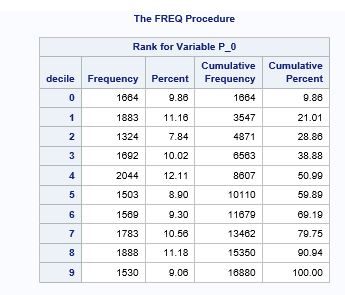- Home
- /
- Analytics
- /
- Stat Procs
- /
- Proc rank decile binning
- RSS Feed
- Mark Topic as New
- Mark Topic as Read
- Float this Topic for Current User
- Bookmark
- Subscribe
- Mute
- Printer Friendly Page
- Mark as New
- Bookmark
- Subscribe
- Mute
- RSS Feed
- Permalink
- Report Inappropriate Content
Hello
In logistic regression after deciling using proc rank, I ran proc freq which returned below output
I am getting different frequencies in each decile, is it necessary that we should get equal number of frequencies in each decile?.
Thanks
Accepted Solutions
- Mark as New
- Bookmark
- Subscribe
- Mute
- RSS Feed
- Permalink
- Report Inappropriate Content
You will not necessarily get identical numbers in each bin. See the example (and cautionary tale) in the article "Binning data by quantiles? Beware of rounded data!"
- Mark as New
- Bookmark
- Subscribe
- Mute
- RSS Feed
- Permalink
- Report Inappropriate Content
Necessary for what? Use the GROUPS= option in PROC RANK if you want to have equal frecuencies in your groups
Small example
proc rank data=sashelp.cars out=carsRanked groups=10;
var invoice;
ranks group;
run;
proc freq data = carsRanked;
tables group / nocum;
run;- Mark as New
- Bookmark
- Subscribe
- Mute
- RSS Feed
- Permalink
- Report Inappropriate Content
You will not necessarily get identical numbers in each bin. See the example (and cautionary tale) in the article "Binning data by quantiles? Beware of rounded data!"
- Mark as New
- Bookmark
- Subscribe
- Mute
- RSS Feed
- Permalink
- Report Inappropriate Content
Thank you very much.
Lets say I want to calculate expected defaults(Y=0), I have 8417/16880=0.499 zeros, then can I say that the expected defaults is 2044*0.499=1019.956 for the decile 4?.
Thank you.

The 2025 SAS Hackathon has begun!
It's finally time to hack! Remember to visit the SAS Hacker's Hub regularly for news and updates.
ANOVA, or Analysis Of Variance, is used to compare the averages or means of two or more populations to better understand how they differ. Watch this tutorial for more.
Find more tutorials on the SAS Users YouTube channel.





